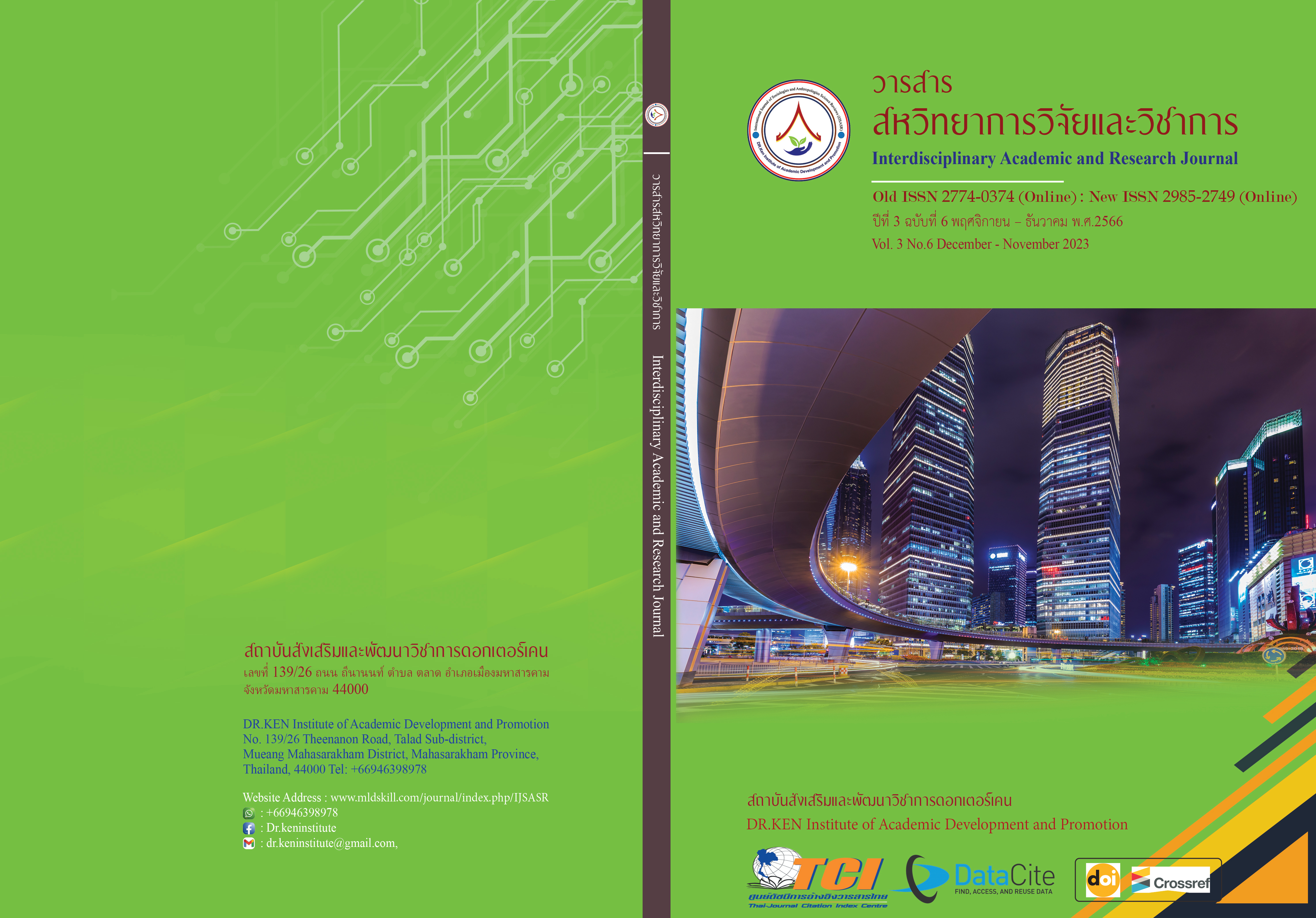A Participatory Management Appoach to Sustainable Waste Management
DOI:
https://doi.org/10.60027/iarj.2023.271450Keywords:
Waste Management Guidelines; , Participation; , Amata Nakorn Industrial EstateAbstract
Background and Aims: Collaborative management remains a good approach to tackling complex problems and requires a commitment to cooperation. However, caution must be exercised, and issues that arise in collaboration must be appropriately addressed to achieve success in collaborative projects or related activities. Sometimes, there may be an imbalance in participation, which can result in certain parties having more influence than others, potentially affecting decision-making and the execution of tasks according to the preferences of the more influential group or party.
Methodology: This study used document analysis and related research methods. Analyze the content and present it descriptively according to the study objectives.
Results: The participatory management guidelines for sustainable waste management at the area level are to be used as a guideline to improve and develop waste management work. By developing a roadmap or projects to create activities for communities to build knowledge, raise awareness, and allow people to participate in sustainable waste management. To reduce the health and environmental impacts caused by waste residues can apply the knowledge gained from this research to consider and apply ineffective contextual waste management. And can adopt a guideline for participation in solid waste management around Amata Nakorn Industrial Estate used as a policy level in the relevant departments, government, and private agencies. The information can be used to advocate policies on household waste management. The participation of the community appropriately in the sustainable community context and as a model for community development around various industrial estates in the future, with a guideline for participation in solid waste management around Amata Nakorn Industrial Estate which can be extended in terms of policy and management through a development path that starts from the status quo to a step-by-step change, such as awareness and understanding of the target group first. and able to disseminate knowledge to society widely.
Conclusion: Participatory management of sustainable waste management aims to improve waste management by emphasizing the development of community plans and activities to create knowledge and awareness. Make people participate in waste management to reduce health and environmental impacts. In addition, it is possible to use participatory approaches to push for waste management policies in government and private agencies. and can be a model for developing communities that value and participate in sustainable waste management.
References
กรมควบคุมมลพิษ. (2561). รายงานสถานการณ์มลพิษของประเทศไทยปี 2560. กรุงเทพฯ.กรมควบคุมมลพิษ. กระทรวงทรัพยากรธรรมชาติและสิ่งแวดล้อม.
กรมควบคุมมลพิษ. (2563). สรุปสถานการณ์มลพิษของประเทศไทย พ.ศ. 2562. กรุงเทพฯ: กระทรวงทรัพยากรธรรมชาติและสิ่งแวดล้อม.
กรมควบคุมมลพิษ. (2564). สรุปสถานการณ์มลพิษของประเทศไทย พ.ศ. 2563. กรุงเทพฯ: กระทรวงทรัพยากรธรรมชาติและสิ่งแวดล้อม.
กรมส่งเสริมการปกครองท้องถิ่น. (2564). แผนปฏิบัติการจัดการขยะมูลฝอยชุมชน “จังหวัดสะอาด” ตามแนวทางประชารัฐ ประจำปี พ.ศ. 2564. กรุงเทพฯ: กระทรวงมหาดไทย.
กองจัดการกากของเสียและสารอันตราย. (2562). เอกสารประกอบการประชุมเชิงปฏิบัติการ “ความร่วมมือในการดำเนินงานด้านการจัดการขยะมูลฝอย”. กรมควบคุมมลพิษ กระทรวงทรัพยากรธรรมชาติและสิ่งแวดล้อม.
เกษร เกษมชื่นยศ. (2563). การพัฒนาของไทยตามเป้าหมายการพัฒนาที่ยั่งยืน. จันทรเกษมสาร, 26(1), 16-30.
คณะรักษาความสงบแห่งชาติ. (2557). มาตรการและแนวทางการแก้ไขปัญหาการจัดการขยะมูลฝอยและของเสียอันตราย. กรุงเทพฯ: กรมควบคุมมลพิษ กระทรวงทรัพยากรธรรมชาติและสิ่งแวดล้อม.
จันจิรา มงคล. (2555). การมีส่วนร่วมของคณะกรรมการสถานศึกษาขั้นพื้นฐานในการจัดการศึกษาของสถานศึกษาเขตพื้นที่การศึกษาประถมศึกษาตาก เขต 2. วิทยานิพนธ์ปริญญามหาบัณฑิต: มหาวิทยาลัยเชียงใหม่.
บานชื่น นักการเรียน. (2559). การพัฒนาที่ยั่งยืน. The Journal of Sirindhornparithat, 17(2), 64-69.
ภาสิต ศิริเทศ, ณพวิทย์ ธรรมสีหา. (2562). ทฤษฎีการรับรู้ความสามารถของตนเองกับพฤติกรรมการดูแลสุขภาพของผู้สูงอายุ. 20(2), 58-65.
รุ่งทิวา แสงหิรัญ. (2561). ทฤษฎีความสามารถของตนเองกับการเลิกสูบบุหรี่. วารสารพยาบาลทหารบก. 18(3), 35-43.
วิจารย์ สิมาฉายา. (2559). แผนแม่บทการบริหารจัดการขยะมูลฝอยของประเทศ (พ.ศ. 2559-2564). Retrieved on 22 May 2022, from: http://infofile.pcd.go.th/waste/PP_Fukuoka2.pdf
สำนักงานเลขาธิการสภาผู้แทนราษฎร. (2562). การจัดการขยะมูลฝอยในประเทศไทย. กรุงเทพฯ: สำนักการพิมพ์ สำนักงานเลขาธิการสภาผู้แทนราษฎร.
อรรครา ธรรมาธิกุล. (2560). การพัฒนารูปแบบการเสริมสร้างพลังอำนาจผู้สูงอายุเพื่อพัฒนาชุมชน. วิทยานิพนธ์ปรัชญาดุษฎีบัณฑิต: มหาวิทยาลัยศิลปากร.
อัจฉราภรณ์ ทวีสิน. (2552). การมีส่วนร่วมของประชาชนในการจัดทำแผนด้านสิ่งแวดล้อม กรณีศึกษาองค์การบริหารส่วนตำบลบางสีทอง อำเภอบางกรวย จังหวัดนนทบุรี. วิทยานิพนธ์ปริญญามหาบัณฑิต : มหาวิทยาลัยธรรมศาสตร์.
Bloom, L., & Selznick, P. (1977). Sociology: A Text with Adapted Readings. 6th edition. N.Y.: Harper and Row, Inc.
Boissevain, J. (2014). Friends of Friends: Network, Manipulators and Coalitions. Oxford: Basil Blackwell.
Economy Division International Environmental. (2017). Technology Centre ASIA OUTLOOK Waste Management SUMMARY FORDECISION-MAKERS. Waste & Resource Management Indicators. Economy Division International Environmental.
The World Bank. (2019). A Global Review of Solid Waste Management, Waste Generation and Recycling Indices Overview and Findings. World Bank, 15(1), 115-122.
World Health Organization. (2019). Waste and human health: Evidence and needs. WHO Meeting Report. World Health Organization, 8(3), 15-22.
Downloads
Published
How to Cite
Issue
Section
License
Copyright (c) 2023 Boonchu Satitmannaitham

This work is licensed under a Creative Commons Attribution-NonCommercial-NoDerivatives 4.0 International License.
Copyright on any article in the Interdisciplinary Academic and Research Journal is retained by the author(s) under the under the Creative Commons Attribution-NonCommercial-NoDerivatives 4.0 International License. Permission to use text, content, images, etc. of publication. Any user to read, download, copy, distribute, print, search, or link to the full texts of articles, crawl them for indexing, pass them as data to software, or use them for any other lawful purpose. But do not use it for commercial use or with the intent to benefit any business.
















.png)


